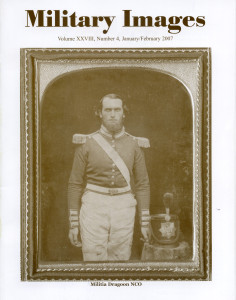The complete issue
Vol. XXVIII, No. 4
(40 pages)
Print edition: Visit our store to check availability
Digital edition: Visit JSTOR.org to purchase
Subscribe to MI
Explore the MI Archives: Browse | Advanced search | Tutorial
Inside
Cover image
A half-plate daguerreotype from the Thom Cole collection is a circa 1850 portrait of a militia dragoon non-commissioned officer in full dress uniform.
Table of Contents (p. 1)
Editor’s Desk and Mail Call (p. 2)
The editor notes that it has been a long while since so many military daguerreotypes have been published in the magazine. He also references upcoming projects.
Passing in Review (p. 3)
Three books are recommended: Confederate Heroines, 120 Southern Women Convicted by Union Military Justice (Louisiana State University Press) by Thomas P. Lowry; War’s Relentless Hand, Twelve Tales of Civil War Soldiers (Louisiana State University Press) by Mark Dunkelman and The Daguerreian Annual 2005 (The Daguerreian Society), edited by Mark S. Johnson and Dawn Patton.
American Military Daguerreotypes From the Collection of Dr. William T. Schultz (pp. 4-23)
A Q&A with Dr. Schultz by James Ronan II (reprinted with permission by the Company of Military Historians) covers the basics of military daguerreotypes and explores various aspects of the collection. A survey of 22 follows, including identified images of Lt. George H. Gordon, U.S. Mounted Rifles; Henry Ledyard, U.S. Charge d’ Affair in Paris; Asst. Surg. Robert Little Brodie, U.S. Army; Midshipman John Gardner Mitchell, U.S. Navy; Lt. Col. Joseph R. Smith, U.S. Army; 1st Lt. William Root, 5th U.S. Infantry; 2nd Lt. William Thompson Mechling, 3rd U.S. Infantry; 1st Lt. William H. Gray, 11th U.S. Infantry and 1st lt. Robert S. Hayward, 13th U.S. Infantry.
“Respetad a la Humanidad!” by Kirk D. Lyons, JD (pp. 24-29)
Subtitled, “The curious history of a Mexican War daguerreotype,” the author, a self-described “keen student of Mexican War photography since my college days,” traces the history of a medical image from the War with Mexico. The photograph pictures Pedro Vander Linden, Chief Surgeon of the Mexican Medical Corps. Captured at the Battle of Cerro Gordo in 1847 when his field hospital was overrun by Americans, Vander Linden, “turned, faced the soldiers with his upraised bloody hands shouting: ‘Respedad a la humanidad, o un hospital de sangre; somos cirujuanos!’ (Respect humanity of this hospital if blood! We are surgeons!)”
Babe Hudspeth: Missouri Guerrilla by John Sickles (pp. 30-33)
Guerrilla fighter William Napoleon “Babe” Hudspeth participated in some of the bloodiest raids of the Civil War. He rode with the likes of William Quantrill, Bloody Bill Anderson and Jesse James and survived his war experience. He died in 1907. The story is illustrated with two cartes de visite from the author’s collection. One is Hudspeth dressed in a Mexican Bolero jacket, and the other pictures him with Oscar Thompson, who also rode with Quantrill.
Uniforms & History by Michael J. McAfee (pp. 33-35)
In “The Military Daguerreotype,” McAfee shares his memory of the first military daguerreotype he purchased, how he came to sell it to well-known collector Herb Peck Jr., and memories of other similar images that passed through his hands. Four images illustrate the column.
The Confederate Soldier (p. 36)
A ninth-plate ruby ambrotype from the Steven Karnes collection is a portrait of an unidentified South Carolina private who served with the Holcombe Legion.
Back Cover Story (p. 38)
The background of the image includes a circa 1846 daguerreotype of the same man dressed in civilian clothes.
Sutler’s Row (p. 39)
The Last Shot (p. 40)
A half-plate ambrotype from the David W. Vaughan collection pictures an unidentified Confederate officer with cavalry-style saber.
Back Cover
A daguerreotype from the Fred Sherfy collection is identified as “Uncle Issac Hull in Civil War.” Though not a Civil War era image, Hull may have served in a militia company.



































